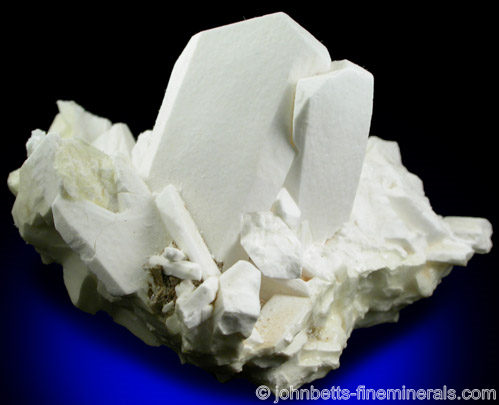The Mineral borax

Borax occurs in arid regions, forming from evaporation of saline lakes. Borax is also synthetically formed as a by-product of mining operations of borate deposits, and most of the specimens from the famous mine at Boron, California, are formed this way.
The first Borax specimens came several dry lake deposits in Tibet. They were shipped in large quantities by ancient caravans for profit. Much greater deposits were later found in the southwestern U.S., from which most of the world's industrial borax comes.
Borax specimens are translucent when fresh, but eventually lose water in their chemical
structure and turn opaque, developing a white powder on their surfaces. If allowed to dehydrate, they will eventually crumble into a white powder. Because of this property, known as
efflorescence, Borax is not commonly seen in collections. When a Borax specimen loses water, it
alters into a new mineral called
Tincalconite, which contains the same elements as Borax but has half the water, and
crystallizes in a different
crystal system.
Chemical Formula
Na2B4O7 ·
10H2O
Color
Colorless, white, light gray. Also in light tints of blue, green, and yellow.
Crystal System
Monoclinic
Properties
Streak
White |
Hardness
2 - 2.5 |
Transparency
Transparent to opaque |
Specific Gravity
1.7 |
Luster
Vitreous to dull |
Cleavage
1,1 |
Fracture
Conchoidal to earthy |
Tenacity
Brittle |
Other ID Marks
1) Has a sweetish, metallic taste.
2) Dissolves in water. |
Crystal Habits
As tall or stubby prismatic crystals. Crystals are generally well-formed and can be quite large. They are usually in disorganized groupings and sometimes striated. Also earthy and encrusting.
Uses
The chemical borax (sodium borate) is essentially the same as the mineral Borax, but the chemical does not contain any water, whereas natural Borax does. The mineral Borax was the primary source for the useful chemical borax, since only the water needs to be removed from the mineral to create the chemical. However, in 1926, the mineral Kernite was discovered in large quantities and is now the primary source of the chemical borax. Kernite contains less water in its structure than Borax.
Borax has numerous industrial uses. It is dissolved in water to form an alkaline antiseptic solution that is used as a disinfectant, detergent, and water softener. It is also used in the manufacture of ceramics, paint, glass, and coated paper. Another important use is as a flux to disintegrate undesired metal oxide stains on metals, and for this reason it is also used in welding. Borax is necessary to conduct a bead test, which is an important method of determining the presence of certain metals in a substance (including minerals).
Noteworthy Localities
The first Borax came from the dry lake deposits in Tibet, China. Now, much of the mined Borax is from the Southwest U.S. The localities there are mostly in California, in Boron, Kern Co. (usually as an artificial by-product of mining operations); Searles Lake, San Bernardino Co.; Borax Lake, Lake Co.; and Death Valley, Inyo Co. It is also found in Nevada in the salt marshes in Esmeralda Co.; and in New Mexico at the Alkali Flat in Dona Ana Co.
Some worldwide occurrences include Kirka and Sarikaya, Turkey; Lardarello, Tuscany, Italy; the Atacma Desert of Chile; and Loma Blanca and Salta, Argentina.
Distingushing Similar Minerals
The unusual properties of Borax distinguish it from all minerals. However, the mineral it alters to, Tincalconite, is the same in appearance, and altered specimens may be incorrectly labeled as Borax.